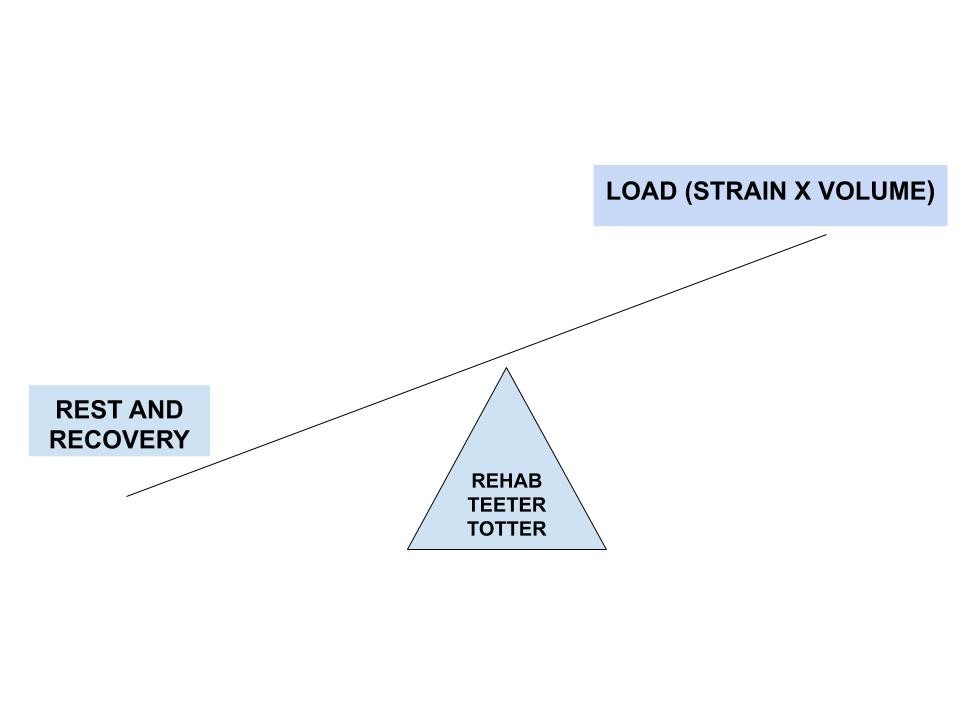The Rehab Teeter-Totter
Understanding Pain
When patients present with pain, we can usually put each patient in one of two categories: they weren’t doing enough activity, or they were doing too much. Let’s give you two examples. The most obvious is in the springtime, when the weather is nicer, people will take up running; but this is after not running for months because of the season and weather. When the person tries to run the same amount of miles, or as fast as they did prior to their hiatus, is when they get in trouble. This is a simple case of "too much, too soon": the amount of excessive load on the tissues causes strain and will send a signal to the brain for help because something is wrong.
Yet, the opposite can also be true! The body was not made to be stagnant; it craves movement. Our cells, our tissues, our brain all benefit from exercise. This population takes “rest” to heart. The lack of movement and the sedentary nature of our 21st century jobs and society are crippling our bodies. This excessive strain from one position (usually sitting), or just a lack of strain overall on the tissues can eventually present with pain as well. Conversely from the population above, our bodies do not want to be in constant states of rest.
The Rehab Teeter-Totter
So, what can we take from this? Well, first, let’s look at two words that were used in both of the prior paragraphs: strain and load. For our purposes, let’s say strain is equivalent to an exercise (pulling, pushing, stretching a muscle, etc.) and load is the exercise volume (how many or how much of it to conduct).
When you begin rehab, it is important to figure out where you, the patient, is on the teeter-totter between strain/load and recovery/rest. If you are sedentary, we need to err on the side of adding the proper exercise to load the tissues inciting an inflammatory response and beginning the healing process. However, if our strain level is too high, we need to add corrective exercises with optimal load to decrease the inflammatory cascade that is occurring. Also, making sure optimal recovery habits are in place.
The rehab teeter totter is an important concept to grasp. This balancing act is something we constantly think about in your visits. We will adjust strain applied on the tissues with rest to best match YOUR complaint. This comes from a proper assessment and detailed history to discover why your tissues are manifesting a painful signal. Having a sports medicine provider who understands the balance of load, strain, rest, recovery, nutrition and programming all specific to your needs and daily life is clearly important to getting out of pain.
A Good Doctor is a Good Coach!
What other career does this sound eerily familiar to? A coach! Someone knowledgeable in sports rehab, or a sports chiropractor, should seem much like a coach when it comes to your treatments. The sessions are usually comprehensive, active, taking you through movements, discussing a plan going forward, and/or even detailing out pictures or visuals to help you grasp the concept. The Latin word for doctor is “teacher” after all…and we at ICT Muscle & Joint Clinic take that to heart!
Teaching you how to get out of pain yourself not only decreases dependency on our care, but also empowers you to be able to know and address what to do when symptoms arise. If you are tired of chronic pain or feel like treatments with your provider are too passive, then seek out a reliable sports chiropractor near you!
About the author
Dr. Sam Reals’ empathy for people in pain motivates him to learn the most up-to-date treatment standards and rehab protocols, encouraging patients to incorporate exercise long after their care plan has concluded. Dr. Sam Reals believes it is only through exercise that people can unlock their true potential and increase longevity to a happy, fulfilling life.
